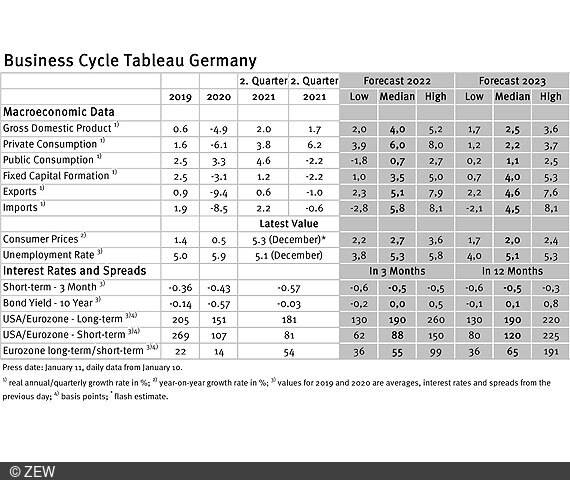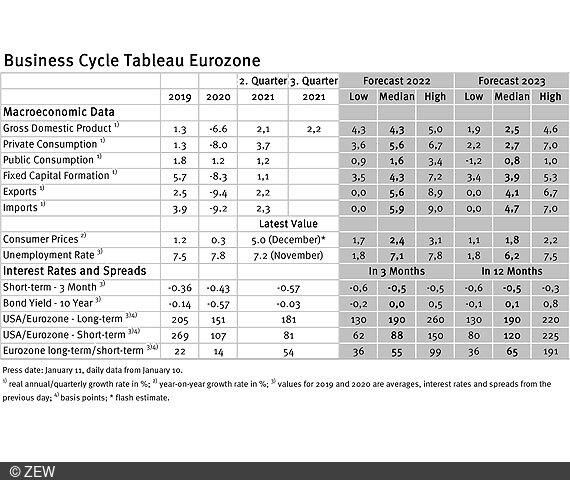Growth Forecasts for 2021 Were Too Optimistic
Business Cycle Tableaus by ZEW and Börsen-ZeitungEconomists Hope to See Economic Growth in 2022
At the beginning of 2021, economic experts had still expected significantly higher growth and, above all, a considerably lower inflation rate for Germany. For 2022, they hope to see the economic growth actually forecast for 2021 for Germany and Europe. Although the current inflation forecasts are being raised, the annual rate of price increase is estimated to be declining. This is the result of the business cycle tableaus by ZEW Mannheim and the German daily newspaper, Börsen-Zeitung.
The growth forecasts for both Europe and Germany in 2021 turned out to be too optimistic, and the strong increase in the inflation rate came as a surprise to many economists. The developments of recent months are having a discernible impact on the forecasts for 2022 and 2023.
(GDP) growth in Germany lower than originally forecast
The median forecast for real gross domestic product (GDP) growth for Germany has been revised downwards for 2022 from 4.5 per cent in December to currently 4.0 per cent. For 2023, the forecast growth is 2.5 per cent. The current figures are very similar to those forecast for 2021 (4.0 per cent) and 2022 (3.3 per cent) a year ago. The high growth expected for last year that did not materialise is now predicted for 2022. For 2022, the forecasts for the euro area are slightly higher than those for Germany, at 4.3 per cent, and the projected value for 2023 is 2.5 per cent for both the eurozone and Germany.
Decline in price increase expected
The inflation forecast for 2022 in Germany was raised in the course of the last four weeks from 2.4 per cent in December to currently 2.7 per cent. However, this still means that the experts expect to see a significant decline in the currently very high price increase of 5.3 per cent over the course of the year. For the coming year, the inflation rate in Germany is expected to fall further to 1.8 per cent. The inflation forecasts for the euro area look very similar. For 2022, the experts assume an average annual price increase rate of 2.4 per cent. This also suggests a marked decline from the 5.0 per cent recorded for December 2021. However, for the first time, the inflation forecast is significantly above the ECB’s target value.
Short-term interest rates in the euro area expected to remain low
However, a clear change in monetary policy expectations is not yet in sight. The experts still expect short-term interest rates in the euro area to remain low – even on a 24-month horizon. For long-term interest rates, they predict only a slight increase. The US Federal Reserve, on the other hand, is expected to pursue a somewhat tighter monetary policy. Accordingly, the projected interest rate differential for short-term interest rates between the USA and the euro area increases.
Business cycle tableaus by ZEW and Börsen-Zeitung
In cooperation with Börsen-Zeitung, ZEW has been publishing monthly business cycle tableaus for Germany and the eurozone with economic key figures and forecasts since 2013. Numerous banks and institutes publish reports on the current and prospective economic situation at different intervals. The information relevant for the tableau is filtered out of these publications to compute a median, minimum and maximum of the available forecasts for the current and subsequent year.
The monthly tableaus show current GDP forecasts, its main components, consumer prices, industrial production, unemployment rate, short- and long-term interest rates, and interest rate spreads. The focus of the tableaus lies on national business cycle reports, which are complemented with forecasts from international banks and institutes. The tableau for the eurozone is enhanced by data from European banks and institutes.

